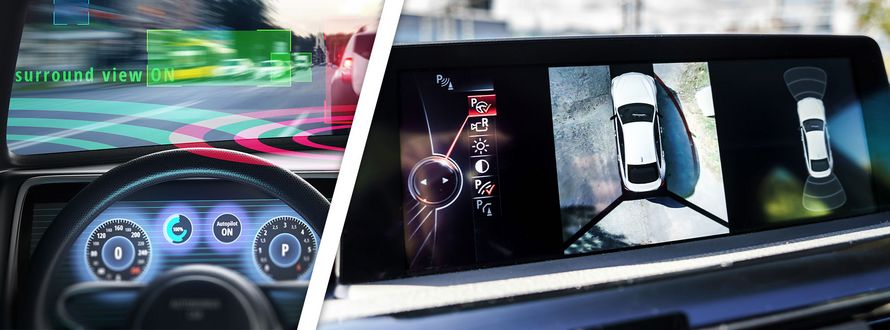
360° Safety: The World of Surround View and Camera-Assisted Driving
– Automotive, SafetyIntelligent assistance systems in vehicles have transformed driving by tackling issues to improve convenience and driver / passenger safety. Adaptive headlights are a good example of how light automation has evolved. They adjust to changing conditions to provide the best visibility possible without blinding oncoming vehicles. With the use of sensors and infrared cameras, night vision helpers can see farther in low light conditions and can identify objects that are invisible to the naked eye. And with the help of a number of cameras, the panoramic view assistant may produce a top-down image of the area around the car, reducing blind spots and improving safety - particularly in larger cars.
Additionally, the overtaking assistants keep an eye on traffic behind the vehicle, which helps to improve general highway safety by preventing sudden maneuvers. Parking helpers reduce the strain of maneuvering through crowded locations by helping with parallel parking or offering remote control for small spots. With the introduction of remote parking, autonomous capabilities have advanced significantly and hands-free parking is now possible.
Together, these technologies solve the difficulties of contemporary driving and advance both safety and a more comfortable and joyful driving experience as they develop further.
Light, Vision and Automation Functions
Explore advanced automotive aides enhancing safety and intelligence for a more secure and intelligent driving environment:
Lighting Automation / Adaptive High Beam
External vehicle sensors detect the brightness of the surroundings, such as when entering a tunnel or during the night. This allows the vehicle's low beam to be automatically activated and deactivated. Advanced systems also use rain sensor data for activation, ensuring compliance with regulations by using low beam and position lights in poor daytime visibility conditions.
Adaptive high beam is another helpful function. Camera systems monitor the space in front of the vehicle when high beams are activated, identifying other vehicles in the same direction and oncoming vehicles in the opposite lane. When these vehicles are detected, the system reacts, temporarily turning off the high beams. Modern systems can adjust specific areas around other road users, ranging from a few sectors to high-resolution systems that accurately outline the contour of the other vehicle.
Automatic light control simplifies vehicle operation and potentially increases the use of low beam with position lights in twilight and poor visibility conditions. Low beam has less glare in rain, fog, or snow than daytime running lights. A high-beam assistant significantly increases the portion of the journey driven with high beams. Timely dimming of headlights for oncoming traffic is crucial for safety, and the assistance system enhances overall road safety for drivers, passengers, and other road users.
Other terms would be Automatic High Beam, Adaptive High Beam Assistant, Light Assist or Matrix LED.
Night Vision Assistant
Special sensors and infrared cameras can detect various objects on the road or roadside at night, that can be invisible to the human eye. To ensure that the camera captures not only heat-emitting objects, the vehicle must emit infrared light, which is reflected by (moving) objects ahead or oncoming. The resulting and calculated night image is displayed on a screen, allowing the driver to detect unprotected and unlit road users, wildlife, or other obstacles earlier, often highlighted graphically and with color borders. The software can also recognize and analyze objects, issuing warnings to the driver.
While looking at the night vision image can be a distraction from the road, safety benefits can arise from software analysis warnings. A emergency braking assistant can quickly intervene if necessary and respond to obstacles on the road. However, a challenge remains in assessing whether emergency braking is necessary or if crossing the obstacle poses less danger to the vehicle and subsequent traffic.
Other terms would be Night View Assist or Night Vision.
360° Surround View Assistant
Using multiple cameras or sensors on the vehicle, the assistance system calculates a "top view" of the vehicle, displaying the immediate surroundings with all obstacles and objects, such as other vehicles, pedestrians, buildings, or trees. Activation occurs during reverse driving or when detecting maneuvering, similar to a rear-view camera. In systems with only front and rear cameras, the environment must be passed once to represent the area beside the vehicle and provide a complete picture.
Low barriers such as bollards or green area protection bars may be poorly visible to the driver without assistance, resulting in damage to the vehicle. Additionally, playing children or animals in the immediate sourrounding of the vehicle can be better detected, and the vehicle can react faster to a dangerous situation if needed. The comprehensive view of the vehicle's immediate surroundings can be a significant aid, especially for vehicles with poor visibility and high window lines, such as vans, trucks, or buses. Drivers can better assess the position and distance to other objects on the assistance system display, significantly enhancing both their own and overall road safety.
Other terms would be Surround View Camera, 360° View Assistant, Area View or Top View.
Windshield Wiper Automation
A sensor on the windshield detects falling raindrops and automatically activates the windshield wipers. The wiping interval is adjusted based on the intensity of the precipitation, ranging from intermittent to continuous high-speed wiping.
Rain sensor-equipped windshield wiper automation is essential in modern vehicles because the camera systems in the windshield, required for emergency braking and lane-keeping assistants, need clear visibility – just like the driver. Clear and improved visibility contributes to increased safety on the road and reduces the risk of accidents.
Adaptive Cruise Control
Unlike cruise control, which maintains a preset speed, the adaptive cruise control measures the distance to the preceding vehicle and adjusts the speed as necessary to maintain a safe following distance. If the vehicle ahead accelerates or changes lanes, the adaptive cruise control resumes the preset speed. Modern systems can also activate the brake or regenerative braking to avoid a collision and operate from and to a complete stop, such as in traffic jams.
Incorporating traffic sign recognition and digital road maps, modern assistants also respond to speed limits and reduce speed before hazardous areas such as sharp curves or roundabouts or brake before intersections without right-of-way. While the adaptive cruise control is primarily designed for comfort, it relieves the driver of monotonous driving tasks and contributes to road safety by helping avoid rear-end collisions due to inattention.
Other terms would be Adaptive Speed Control, Automatic Distance Control or Travel Assist.
Lane-Keeping Assistant
Unlike a lane departure warning system, which only intervenes when the vehicle is about to leave the lane, the lane-keeping assistant aims to keep the vehicle in the center of the lane and autonomously steers the vehicle permanently. Lane detection is performed using camera systems, typically in the windshield. To confirm the driver's presence, the steering wheel must be lightly gripped; otherwise, the system deactivates. It also deactivates if lane markings are not recognized. The steering forces are limited, allowing the driver to override the assistant and take control of the vehicle at any time.
The lane-keeping or steering assistant is a pure comfort function, and the driver must monitor it constantly, bearing full responsibility for its operation. The actual driving task should never be completely relinquished, as this is not an automated or autonomous driving system.
Other terms would be Steering Assistant or Highway Assistant.
Traffic Jam Assistant
Up to speeds of 60 km/h, the traffic jam assistant takes over the steering of the vehicle on multi-lane roads such as highways, accelerates and brakes, and keeps the vehicle in the lane without the driver's intervention. Cameras or sensors capture the vehicle's surroundings and analyze the movement of surrounding traffic. If other road users slow down, the vehicle also slows down. Even after a brief stop, the car resumes driving automatically. Actions by the driver, such as steering, pedal operation, or signaling, terminate the traffic jam assistance.
In situations like traffic jams or slow-moving traffic, especially if they persist, the driver's attention may wane. Here, a system can take over the rather monotonous driving task, contributing to traffic safety by preventing rear-end collisions and vehicle contacts due to the driver's inattention. However, the driver still bears full responsibility for vehicle control and must not engage in other distracting tasks.
Other terms would be Driving Assist or Drive Pilot.
Overtaking Assistant
To support a safe overtaking maneuver, the assistance system monitors the following traffic on the highway, preventing quick lane changes or overlooking other vehicles. If the lane is clear, the vehicle changes lanes, merges into the passing lane, and accelerates to the speed set in the cruise control. The driver activates the overtaking maneuver by using the turn signal (to the left).
The overtaking assistant is a step toward expanding the system in conjunction with automated lane-keeping or a building block for automated driving. It secures overtaking maneuvers, contributing to road safety. Since these assistance systems "see" differently than humans, poorly or not illuminated and difficult-to-recognize vehicles (such as motorcycles) can be better detected.
Parking Assistant
Using cameras and/or sensors, the vehicle assesses during slow passage whether a parking space is sufficiently large. For correct reverse parking, the driver only needs to engage the reverse gear and control the gas and brake; the assistant takes over steering fully automatically. Some assistants also assist in forward parking out of longitudinal parking spaces. Advanced systems handle the entire process automatically, including acceleration and braking.
Different parking situations on the road can pose a challenge for drivers, making assistants a genuine aid for safer and faster parking. However, the assistant typically requires larger clearances from other vehicles and obstacles for reliable parking actions.
Another terms would also be Park Steering Assistant.
Remote Parking
Using a smartphone app or a control unit on the car key, the vehicle can be parked and unparked externally without the driver needing to be inside the car. The vehicle monitors and performs the driving and steering functions on its own. However, the driver must prove his presence through an action on the control unit or app. If the driver stops the action (for example, movement of the finger on the touch screen), the vehicle also immediately stops the parking function.
Remote or remote-activated parking is particularly interesting when there is little or no space next to the vehicle for getting in or out. Often, the assistant only requires a clearance of 40 centimeters next to the vehicle. This assistant is a stepping stone towards autonomous parking, for example, in parking garages, where the driver is no longer present.
However, a driver's action is always necessary, so the system should not be confused with Automatic Valet Parking. In this case, the system not only takes over the parking space search from the driver but also the entire parking process in the parking garage. The vehicle only needs to be parked at a designated location, and intelligent infrastructure, along with vehicle technology, takes care of the journey to the available parking space and the actual parking process.
Other terms for this technology would be Parking Assistant or Unpark Assistant.
How can SYSGO be involved?
SYSGO is specialized in providing solutions for safety and security-critical systems for automotive applications, particularly in the field of embedded software. The challenges outlined, related to various advanced driver assistance systems (ADAS), fall within SYSGO's expertise in developing reliable and secure software for the automotive industry.
Here is how SYSGO addresses these challenges through a range of specialized technologies and services:
Real-Time Operating System (RTOS): SYSGO provides a real-time operating system, PikeOS, designed to meet the demanding requirements of automotive applications. PikeOS allows for the partitioning of the system into multiple independent and isolated execution environments, supporting both safety-critical and non-safety critical functions on the same hardware. This ensures that critical tasks, such as those related to light, vision, and automation functions, can be executed with the necessary determinism and reliability.
Hypervisor Technology: SYSGO's hypervisor technology is integral for achieving functional safety and security in automotive systems. With the ability to run multiple operating systems (such as Android, Linux, or AGL) simultaneously on a single hardware platform, SYSGO's hypervisor ensures the isolation of critical functions. This is crucial for scenarios where light, vision, and automation functions need to operate independently and reliably.
Secure Software Development: SYSGO emphasizes secure software development practices to mitigate vulnerabilities and enhance the robustness of automotive systems. This includes adherence to industry standards such as ISO 26262 for functional safety in automotive. By employing a secure development life cycle, we contribute to building trustworthy software solutions for the embedded automotive market.
Certification Standards: We understand the importance of compliance with industry standards and certification requirements. The company's solutions are designed to meet standards like ISO 26262 (Functional Safety), ISO 21434 (Automotive Cybersecurity). This commitment to certification ensures that the software components integrated into vehicles meet the necessary safety and security levels.
Integration with Sensor Technologies: Given the focus on light, vision, and automation functions, SYSGO's solutions seamlessly integrate with sensor technologies commonly used in ADAS. This includes LiDAR, radar, cameras, and other sensors critical for perception in autonomous and semi-autonomous vehicles. The real-time capabilities of SYSGO's solutions contribute to the efficient processing of sensor data for timely decision-making.
Middleware and Communication Protocols: SYSGO provides middleware and communication protocols that facilitate the interaction between various components in the automotive ecosystem. This is essential for coordinating light, vision, and automation functions across different systems within the vehicle architecture, enabling a cohesive and responsive ADAS.
SACoP - Secure Automotive Connectivity Platform
SACoP excels as a turn-key, secure automotive connectivity platform by seamlessly integrating with SYSGO's safety-critical solutions. With its plug-and-play functionality, SACoP ensures swift deployment, enabling real-time communication between vehicles and infrastructure. Its robust security protocols enhance the resilience of automotive networks, fostering reliable connectivity for advanced driver assistance systems (ADAS) and contributing to the overall safety and efficiency of connected vehicles.
Find out more at www.sysgo.com/sacop
In summary, SYSGO's solutions for the embedded automotive market encompass a comprehensive approach to address the challenges of safety, security, and reliability in advanced driver assistance systems. Through technologies like PikeOS, hypervisor technology, secure software development practices, adherence to certification standards, integration with sensor technologies, and middleware support, SYSGO aims to provide a robust foundation for the development of cutting-edge automotive applications.
---
Find out more at www.sysgo.com/pikeos
Find out more at www.sysgo.com/elinos
-
Previous
-
Next

 Twitter
Twitter LinkedIn
LinkedIn Facebook
Facebook Reddit
Reddit RSS
RSS Copy link
Copy link
